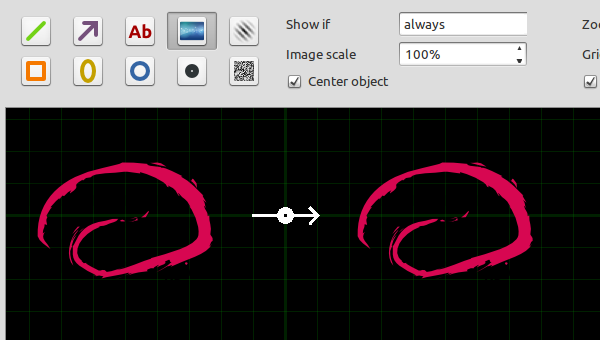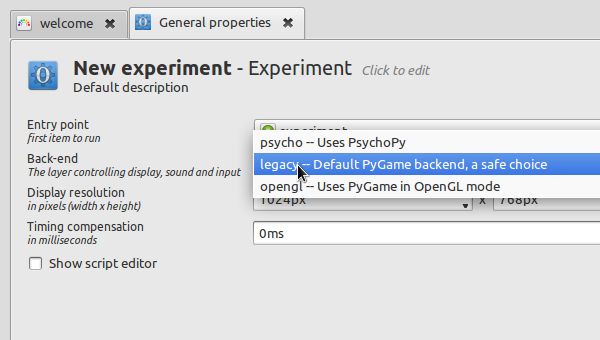In the spotlight: OpenSesame¶
I suspect that many of you will not be familiar with me or my software, so let’s start with a brief introduction. My name is Sebastiaan Mathôt. I’m the lead developer of OpenSesame, a graphical tool for creating psychological and neuroscientific experiments.
About OpenSesame¶
The reason that I started working on OpenSesame, aside from the inherent pleasure that a geek like myself derives from developing software, was my dissatisfaction with the tools that were available. Not that there’s a shortage of experiment building software, not at all. And for people with reasonable programming skills there are many viable options: MatLab/ Octave in combination with the Psychophysics Toolbox, Python in combination with VisionEgg or PsychoPy, to name but a few (most of these are, incidentally, available through NeuroDebian). But for people with relatively modest programming skills, such as most students doing a Bachelor’s or Master’s project, there aren’t that many options. In my experience, people will generally end up using a proprietary program, such as E-Prime, Inquisit, or what have you. These offer a reasonably intuitive graphical interface, but at a price. First, these packages are expensive and, due to licensing restrictions, people are frequently unable to install them on their personal computers. Second, they are limited in their functionality and in their interoperability with other software.

One of the unique features of OpenSesame is the ability to draw your stimuli. You can combine this what-you-see-is-what-you-get approach with scripting, to easily create flexible stimulus displays.¶
Therefore, I wanted to develop a graphical environment for building experiments, centered around the Python programming language. The idea was to give users the type of comprehensive graphical interface that they have come to expect from proprietary packages, but for free, and without taking away any of the power that Python has to offer. And, almost a year, 12 public releases, and more than 10,000 downloads later, the result is OpenSesame!
Back-end independence¶
In this post I want to highlight one of OpenSesame’s features: back-end independence. This may sound a bit technical and boring, but it’s not. Well… maybe a little boring. In fact, it should be a little boring, because it’s a feature that you’re not supposed too notice, unless you need it.
So what do I mean by “back-end independence”? Experiments are all about presenting stimuli. Most often visual stimuli on a computer display, sometimes sounds, tactile stimuli, etc. From the perspective of a programmer, there are many ways to present such stimuli. Put differently, there are many programming libraries that you can use.
For example, if you want to write a program that controls a computer display, you can use a Python library called PyGame. PyGame has been designed with video-games in mind, but, experiments being conceptually so similar (although not typically as entertaining), it is also well suited for creating experiments. For this reason, I initially designed OpenSesame around PyGame.
This seemed like a good idea at the time, but there was a huge drawback. If people wanted to use OpenSesame, they were forced to use PyGame as well. It was a package deal, so if PyGame didn’t support a particular feature, neither did OpenSesame. That wasn’t very nice. And it also wasn’t necessary, because there was nothing in OpenSesame that inherently required PyGame. It was just an arbitrary design choice that I had made at the outset.
So I decided to decouple the “back-end” (i.e., all the functions that had been handled by PyGame up to that point) from the rest of OpenSesame. This means that the user can now choose which back-end he or she wants to use for controlling the display etc. Importantly, OpenSesame continues to function in the same way, regardless of which back-end is selected. For users who don’t care or know what a back-end is, let alone which back-end they prefer, PyGame still serves as a default.

You can easily select your favorite back-end using the graphical interface. The same experiment can be run, (usually) completely unmodified, using any of the three available back-ends.¶
So what’s the upshot of all this? Right now, the most direct benefit is that you can use OpenGL and PsychoPy in your OpenSesame experiments. PsychoPy in particular provides lots of functions (drawing Gabor patches etc.) that are very convenient when creating experiments. Previously, users couldn’t use these, because PsychoPy doesn’t play nice with PyGame (even though it actually uses, or can use, PyGame under the hood). Now they can, so that’s a definite plus. And in the future I may add more back-ends, depending on popular demand. For example, VisionEgg is another library for creating experiments. VisionEgg is quite popular and could probably be used as a back-end as well.
This means that users of OpenSesame now have both a comprehensive graphical interface and powerful programming libraries at their disposal. They can choose. Most of the experiment can usually be created using the GUI, which is especially appealing for the less tech-savvy among us. But, for more complicated parts, Python scripting can be used and, consequently, users have access to a wide range of libraries.
I think that OpenSesame’s back-end independence is a nice example (one of many, I hasten to add) of how free software can work together. If it hadn’t been possible to use PsychoPy and OpenGL in OpenSesame, I would have probably ended up duplicating lots of functionality. That would have been very time consuming. Time that I have now spent on refining other parts of OpenSesame, unique parts and not simply duplicates of existing functionality.
And ultimately, I believe that this type of interoperability is why free software will continue to grow.











